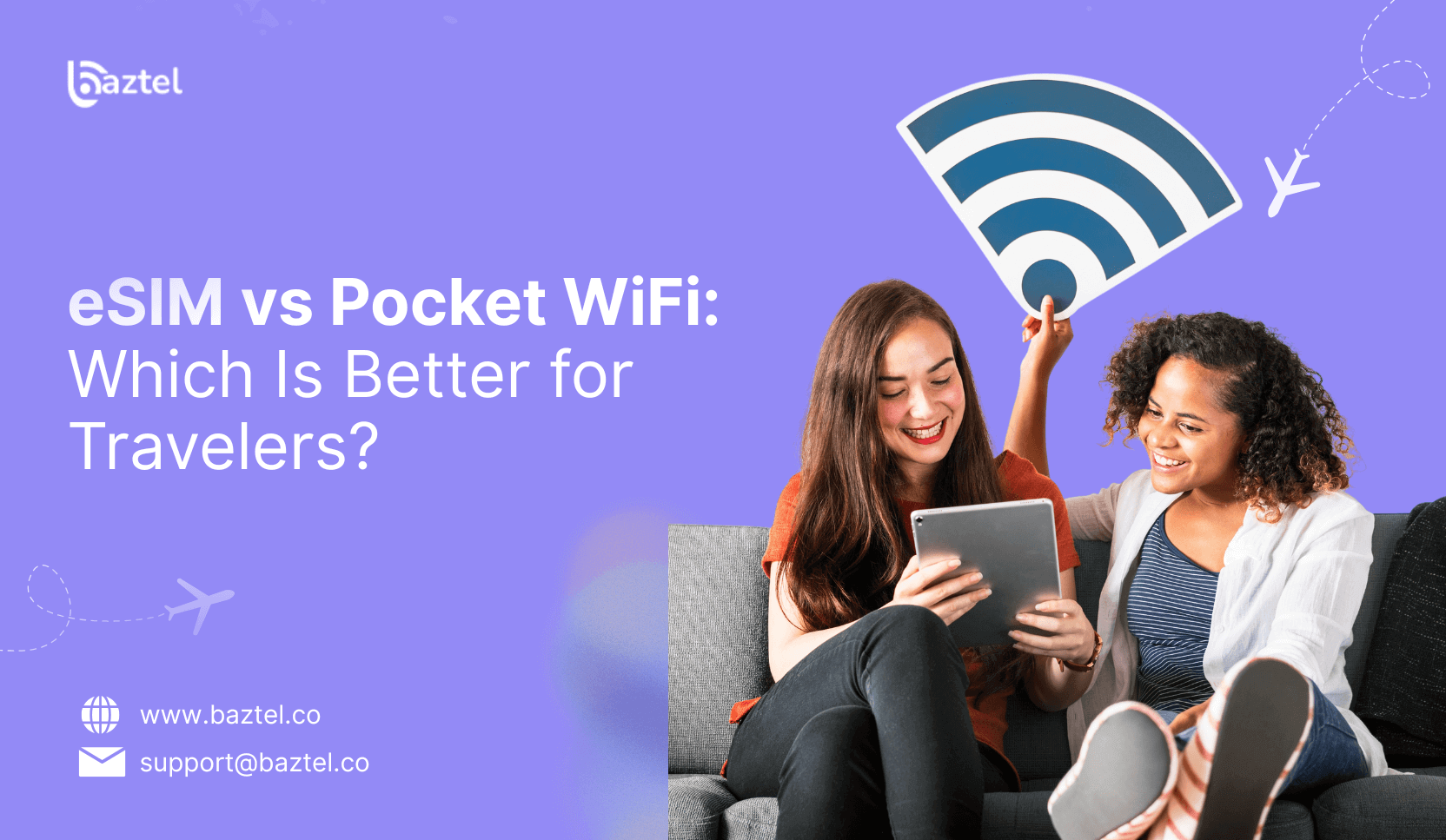You’ve packed your bags. Tickets are booked. Now comes the tricky part — how will you stay online once you land?
That’s where the real question begins: eSIM vs Pocket WiFi — which one actually works better when you’re on the move? This article compares eSIM and Pocket WiFi options for travelers in Europe, helping you decide which is best for your trip.
This guide is for anyone planning a trip to Europe and wondering how to stay connected. We’ll compare eSIM and Pocket WiFi options, so you can choose the best solution for your travel style, budget, and connectivity needs. Whether you’re a solo adventurer, a family, or a business traveler, making the right choice can save you money, reduce hassle, and ensure you have reliable internet access throughout your journey.
Both do the job. But they work differently. If you choose wrong, you might end up paying extra, losing connection midway, or carrying unnecessary gadgets throughout your trip.
This guide breaks it down in plain language. No jargon. Just real answers to help you pick what fits your travel style.
What Is an eSIM and How Does It Work While Travelling?
An eSIM is a digital alternative to the traditional SIM card that allows activation of a cellular plan without a physical card. An eSIM is a digital SIM built into your phone. You don’t need to insert any chips or visit a local store. eSIM technology is an embedded SIM that enables instant connectivity and seamless switching between networks, providing reliable connectivity for travelers.
Just scan a QR code or download a plan through an app — and you’re ready to use mobile data abroad. eSIM plans can be purchased from providers like Airalo, BazTel and Holafly, and many eSIM plans are available to suit different travel needs, including local or regional data plans and flexible cellular plan options.
It connects to local networks the same way a physical SIM does. But the big plus? No need to remove your original SIM or carry anything extra. eSIMs allow users to keep their home number active while using local data, thanks to dual SIM functionality.
Many travelers now prefer eSIMs because they work instantly, don’t need delivery or pickup, and are available even before your flight. eSIMs use secure cryptographic protocols for safe remote provisioning. You can land, switch it on, and start using the internet in minutes. eSIM plans are often valid for a set number of days, with costs decreasing for longer durations.
In the eSIM vs Pocket WiFi debate, this digital option is winning hearts for short trips, solo travel, or when you want fewer things to worry about. eSIMs are generally more convenient for solo travelers or short trips due to their instant setup and lack of additional hardware. They are also more cost-efficient per GB for individuals or couples traveling across multiple countries, offering seamless connectivity and hassle-free internet access.
No plastic, no swapping — just scan and go
With a regular SIM, you need to remove the tray, insert the card, and restart your phone. With a traditional SIM card, this process is called sim swapping, where you physically exchange SIMs to change networks or plans. With an eSIM, none of that happens. You simply scan a QR code or activate a plan from an app. Within minutes, your phone gets a working mobile network — no physical SIM involved.
Works instantly in most modern smartphones
Most phones launched in the last few years already support eSIM. Brands like Apple, Samsung, and Google have this built-in. However, device compatibility is crucial—always verify that your device supports eSIM technology and check your phone settings to ensure everything is configured correctly for data usage and connectivity. If your phone is compatible and unlocked, eSIM works straight out of the box. You can use the ZenSim Compatibility Checker to confirm if your smartphone is ready for eSIM. No tools, no shop visits — just turn it on and go online.
Ideal for solo travelers and digital nomads
If you travel light and alone, eSIM is made for you. It removes the need to pick up a SIM or rent a WiFi device. You stay connected using just your phone, and that too without delays. For people who move often or switch countries, eSIM saves time and effort
What Exactly Is Pocket WiFi and Why Do Travelers Still Use It?
Pocket WiFi is a portable router that connects to a cellular network and creates a personal WiFi hotspot. A Pocket WiFi is a small, portable device that works like a mini router. This small device, often referred to as a dedicated device or mobile hotspot, connects to local mobile networks using a local SIM card. You carry it in your bag, switch it on, and it creates a WiFi network for your phone, laptop, or tablet — just like your home broadband.
Pocket WiFi works by creating a password protected network, providing a secure personal WiFi hotspot for multiple devices to connect to the internet simultaneously. It acts as a portable router that connects to a cellular network and often comes with unlimited data options, which is appealing for heavy users. Pocket WiFi may have a more powerful antenna, providing better signals in rural areas compared to eSIM.
You don’t need to change anything on your phone. It’s plug-and-play. Great for people using multiple gadgets or travelling in a group.
But there’s a flip side. You need to charge it. Carry it everywhere. And if you forget it at the hotel or lose it — that’s a big headache. Some providers also ask for a deposit or charge late return fees.
In the eSIM vs Pocket WiFi comparison, this option still makes sense for families, teams, or digital nomads who work on the go and need multiple devices online at once.
A tiny router you carry in your pocket
Pocket WiFi is a small, battery-powered device that connects to mobile networks and gives you WiFi wherever you are. It fits in your bag or jacket — but it’s still one more thing to carry during your trip.
Connects multiple devices at once
One Pocket WiFi can support 5 to 10 devices. This means you can connect multiple devices simultaneously, offering multi device connectivity through one connection. You, your friend, your laptop, and even a tablet can all connect using the same signal. It’s useful when you’re travelling with others or need the internet on more than just your phone. Pocket WiFi can provide stable connections for several users, but may involve more logistical efforts, such as rental fees or battery management.
Useful for families or team trips
Families, business groups, or friends who move around together often pick Pocket WiFi. Pocket WiFi is ideal for families or groups who need to connect additional devices, making it a more cost-effective solution for group travel. Instead of buying a separate SIM or eSIM for each person, one shared device handles everything. It also helps people stay connected when they’re close by.
Do I Need an Unlocked Phone for eSIM or Pocket WiFi?
Before you choose anything, check your phone’s lock status. That’s the first step most people miss.
To use an eSIM, your phone needs to be unlocked and eSIM-supported. Not all older models work with eSIM. And if your phone is locked to a local network, the eSIM won’t activate. Device compatibility is crucial—make sure your device supports eSIM technology before considering this option.
On the other hand, Pocket WiFi doesn’t care what phone you’re using. Whether it’s locked, old, or not eSIM-ready — it’ll still work. As long as your device can connect to WiFi, you’re good to go.
So in the eSIM vs Pocket WiFi choice, it also depends on your phone’s hardware. If you’re using a basic handset or a company-locked device, Pocket WiFi might be your safer bet.
In 2025, the best solution between eSIM and Pocket WiFi depends on device compatibility and the size of your travel group.
eSIM requires an unlocked, compatible device
To use an eSIM while travelling, your phone must be unlocked. If it’s tied to your home network, the eSIM won’t work abroad. Also, not all phones support eSIM — you need to check if your model has this feature built in.
Pocket WiFi works with locked or old phones
Pocket WiFi doesn’t care whether your phone is locked or not. It simply sends out WiFi, and any device can connect. Even older smartphones, tablets, or laptops will work without issues.
One’s plug-and-play, the other needs a check
Pocket WiFi is easier when you’re unsure about your phone. Just switch it on and connect. But with eSIM, you need to confirm compatibility and unlock status before buying any plan — or it won’t activate at all.
Can I Use an eSIM as a Hotspot for Other Devices?
Yes, in most cases you can. Once your eSIM is active and you have mobile data, you can turn on hotspot from your phone and connect other devices — just like regular mobile data sharing. However, sharing your data connection via hotspot can impact your phone’s battery life, so it’s important to monitor battery usage when tethering.
But there’s a catch. Not all travel eSIMs allow hotspot usage. Some providers limit sharing or reduce speed when you connect multiple devices. Always check the plan details before buying.
Both eSIM and Pocket WiFi provide access to essential services like Google Maps, accommodations, and translation apps, but speed and reliability can vary depending on your data connection and the region.
Pocket WiFi, on the other hand, is built exactly for this. It supports 5 to 10 connections at once. So if you’re carrying a tablet, laptop, and phone — or if you’re travelling with others — it might be more practical.
So in eSIM vs Pocket WiFi terms, both can share internet. But Pocket WiFi is made for it. eSIM allows it — if your plan supports it.
Which One’s Easier to Set Up on the Go?
If you want something ready before you land, eSIM is the clear winner. You can buy a plan online, scan a QR code, and activate it within minutes — no waiting, no pickup, no local store.
You can even install it before your flight. Once you land, just turn on mobile data, and you’re connected.
With Pocket WiFi, you usually have to book it in advance. Then pick it up at the airport or hotel. You also need to return it later — or pay a penalty. Not a big deal if you’re staying in one place, but a hassle if you’re hopping cities. Pocket WiFi rentals often come with daily rental fees that vary by country and duration, and require managing battery and rental logistics, making them generally more expensive than eSIM.
In the eSIM vs Pocket WiFi setup game, eSIM takes less time and effort — especially for solo or first-time travelers.
How Do They Compare in Speed and Network Stability?
Speed depends more on the local mobile network than the tool you’re using.
With eSIM, your phone connects directly to the provider’s 4G or 5G network. In cities or tourist spots, speeds are usually great. But in remote areas or crowded zones, signal drops can happen — just like with any local SIM. eSIM technology is designed to provide reliable connectivity and stable connections, ensuring fast network access for international travel and seamless roaming experiences.
Pocket WiFi also uses mobile networks, but the device sometimes catches stronger signals because it’s designed for data use. It also supports multiple bands, which can help in weak zones. Pocket WiFi devices can offer fast and stable connections, providing reliable internet access even in rural areas due to their more powerful antennas. This makes them ideal for travelers who need reliable internet in various environments.
Still, for casual use like browsing, WhatsApp, or booking cabs — you won’t notice much difference between the two. Both eSIM and Pocket WiFi aim to provide stable connections and reliable internet for travelers.
In the eSIM vs Pocket WiFi speed check, it’s mostly a tie — unless you’re in rural areas or need super stable connectivity for work.
Speed depends on the local provider
Whether you use an eSIM or Pocket WiFi, the actual speed depends on the mobile network in that country. If the provider offers strong 4G or 5G coverage, both options will give fast internet. If the area has weak signals, both will slow down.
Pocket WiFi may perform better in rural zones
Some Pocket WiFi devices support multiple bands or come with signal boosters. This gives them a slight edge in areas where coverage is patchy. They might hold on to weak signals better than regular phones using eSIM.
eSIMs vary by plan and region
Not all eSIM providers give the same speed. Some offer high-speed data, while others may slow down after a certain limit. It’s also affected by which country you’re in — urban areas are mostly fine, but remote spots may be tricky.
Which Is More Portable and Travel Friendly?
Travel is tiring as it is — the last thing you want is to carry extra gear.
With eSIM, there’s nothing new to carry. It’s built into your phone. No cables, no box, no pouch. You just walk around with one device, and everything works.
Pocket WiFi adds one more thing to your bag. You need to carry the device, remember to charge it, and keep it safe. It also comes with cables and sometimes a case — not ideal if you travel light.
In short trips or when moving between cities, this can feel like a burden.
Relying on public WiFi in hotels, crowded airports, or even shared ‘private’ networks can expose you to hackers, rogue hotspots, and unwanted tracking. Using personal devices like eSIM or Pocket WiFi is a safer alternative for reliable internet access, especially in areas where public WiFi might be unavailable or unreliable.
When it comes to eSIM vs Pocket WiFi, eSIM clearly wins for portability. One less item to manage makes travel simpler
eSIM uses your phone’s existing battery
When you use an eSIM, you don’t carry anything extra. The data runs through your phone just like a regular SIM. So there’s no second device to charge or manage — you only keep an eye on your phone’s battery, as usual.
Pocket WiFi needs charging every few hours
Most Pocket WiFi devices run for 6 to 10 hours. That may sound enough, but on long sightseeing days or late travel, it often dies before you get back. You’ll need a power bank or charging stop — or you’ll lose connection midway.
One less thing to charge makes a difference
Travelling is tiring already. Managing two devices, two chargers, and two batteries adds to the load. With eSIM, you keep things lighter. One device. One cable. One simple routine.
Battery Life: Which Option Lasts Through the Day?
When you’re out exploring all day, battery life becomes a real issue. With Pocket WiFi, you’re not just using your phone — you’re also relying on another device that needs charging. And if it dies, your internet goes with it. eSIM keeps things simple by working directly through your phone, with no extra gadgets to worry about. Let’s see which one actually lasts longer when you’re on the move.
eSIM uses your phone’s existing battery
When you use an eSIM, you don’t carry anything extra. The data runs through your phone just like a regular SIM. So there’s no second device to charge or manage — you only keep an eye on your phone’s battery, as usual.
Pocket WiFi needs charging every few hours
Most Pocket WiFi devices run for 6 to 10 hours. That may sound enough, but on long sightseeing days or late travel, it often dies before you get back. You’ll need a power bank or charging stop — or you’ll lose connection midway.
One less thing to charge makes a difference
Travelling is tiring already. Managing two devices, two chargers, and two batteries adds to the load. With eSIM, you keep things lighter. One device. One cable. One simple routine.
What If You Lose Your Pocket WiFi Device?
Losing the internet while travelling is one thing. But losing the device that gives it? That’s a bigger headache.
Pocket WiFi comes with a return policy. If you misplace it, damage it, or return it late — you might end up paying a fine. That’s a lot for a small gadget you didn’t even keep.
With an eSIM, there’s nothing to lose. It’s inside your phone. You don’t return anything, carry anything, or worry about device safety. Even if you lose your phone, you’d still have the same problem — but not an added penalty.
So in the eSIM vs Pocket WiFi debate, this is where eSIM clearly wins. Less baggage. No deposits. No risk of extra charges at checkout.
Hidden Costs: What You Might Miss in Price Comparisons
At first glance, both options might seem affordable. But a closer look reveals hidden expenses you shouldn’t ignore.
With Pocket WiFi, the daily rental runs about US $10–15, and weekly plans are priced around US$35. On top of that, you’re often required to pay a refundable deposit, usually US $50–100, depending on the provider. Don’t forget costs for overnight shipping, insurance add-ons, or late-return penalties—these extras can quickly double your bill. Many Pocket WiFi rentals also offer unlimited data options, which is especially appealing for heavy users or groups needing stable connections for several users, but these unlimited data plans may involve additional rental fees and require you to manage battery life during your trip.
In contrast, eSIM plans are simpler. You pay a one-time fee upfront that usually reflects the full cost. Most plans clearly list data limits and price, with no hidden charges. That means no deposits. No device returned. No surprise fees if your travel dates shift. As an example, BazTel European eSIM plans starting at just US$1 for for a 7-day plan with 1GB of data. You can’t really beat that!
So when you compare eSIM vs Pocket WiFi, don’t just look at the sticker price. Consider all the extras that could impact your wallet before you land.
Solo Trip or Group Travel: Which Option Suits You?
Not all trips are the same. And that changes what internet option works best for you.
If you’re travelling solo, the choice is easy — an eSIM gives you quick setup, no baggage, and full control from your phone. You don’t have to worry about return dates, charging cables, or anyone else using your data. However, eSIMs are often data-only and typically lack a local phone number for calls or texts.
But if you’re travelling with friends, family, or co-workers, Pocket WiFi can make sense. One device can support multiple phones, laptops, and tablets at once. You all stay connected — as long as you’re together. It’s useful for group tours, business trips, or when everyone wants the internet but not everyone wants to buy a separate plan.
Pocket WiFi is also ideal for remote workers who need reliable, high-capacity internet for video calls and other data-intensive activities, making it a strong choice for long trips or working from remote regions.
So in the eSIM vs Pocket WiFi decision, think about how you’re travelling. Alone? Keep it light with eSIM. In a group? Pocket WiFi may give better value.
Side-by-Side Comparison: eSIM vs Pocket WiFi
If you’re still unsure, here’s a quick breakdown of how both options stack up in real-world travel situations:
- Setup:
- eSIM: QR code, instant activation
- Pocket WiFi: Needs pickup/delivery and return
- Portability:
- eSIM: Built into phone, no device to carry
- Pocket WiFi: Extra device + charger needed
- Device Support:
- eSIM: Works on one phone
- Pocket WiFi: Can connect 5–10 devices
- Battery Life:
- eSIM: Uses phone battery
- Pocket WiFi: Needs separate charging (6–10 hrs)
- Speed:
- eSIM: Depends on local network
- Pocket WiFi: Often similar, may perform better rurally
- Cost Transparency:
- eSIM: Upfront pricing, no hidden charges
- Pocket WiFi: May include deposits, late fees
- Risk Factor:
- eSIM: Nothing to lose physically
- Pocket WiFi: Loss/damage can lead to penalties
- Internet Access:
- eSIM: Reliable internet access via local mobile networks
- Pocket WiFi: Reliable internet access for multiple devices
- Data Roaming:
- eSIM: Avoids high data roaming fees by using local networks
- Pocket WiFi: Avoids roaming fees, uses local data plans
- SIM Type:
- eSIM: Digital alternative to physical SIM card; connects to local mobile networks for dependable signal strength
- Pocket WiFi: No SIM card swap needed; works independently
- Best For:
- eSIM: Solo travellers, frequent flyers
- Pocket WiFi: Groups, business teams, gadget-heavy users
Both eSIM and Pocket WiFi are popular internet solutions for travelers in Europe, providing stable internet access and helping you avoid expensive data roaming charges. eSIMs are a digital alternative to traditional physical SIM cards, and typically connect to local mobile networks for dependable signal strength. Pocket WiFi offers a portable internet solution for groups or multiple devices, also bypassing roaming fees.
Summary: Main Decision Factors for eSIM vs Pocket WiFi in Europe
In 2025, the choice between eSIM and Pocket WiFi depends on device compatibility and group size. Here’s a quick summary to help you decide:
- Device Compatibility:
- eSIM requires an unlocked, eSIM-compatible phone.
- Pocket WiFi works with any WiFi-enabled device, regardless of lock status.
- Group Size & Device Use:
- eSIM is best for solo travel or phone-only use.
- Pocket WiFi is suited for groups or when you need to connect multiple devices.
- Cost:
- Pocket WiFi is often more cost-effective for families or groups who need to connect multiple devices.
- eSIMs are often more cost-efficient per GB for individuals or couples, especially for seamless multi-country travel.
- Travel Style:
- eSIM is ideal for those who want instant setup, minimal baggage, and easy management.
- Pocket WiFi requires managing battery, rental logistics, and is generally more expensive than eSIM.
- Coverage:
- Pocket WiFi may offer better signal in rural areas due to more powerful antennas.
- eSIM offers seamless connectivity in urban and most tourist areas.
Consider these factors to choose the best connectivity solution for your European adventure.
Final Verdict: What Should You Pick for Your Next Trip?
There’s no one-size-fits-all answer. It really depends on how you travel, what devices you carry, and how much freedom you want.
If you like to travel light, don’t want to worry about return dates or charging extra gadgets, then eSIM is the better choice. You just scan, activate, and go online — all from your phone. eSIM is a cost-efficient and cost-effective solution for solo travelers with compatible phones.
But if you’re travelling in a group, need to share the internet with multiple people, or plan to use laptops and tablets too, then Pocket WiFi still has its place. Pocket WiFi advantages include the ability to connect several devices at once, making it ideal for families, group travel, and heavy users who need reliable internet for work or entertainment. It is also a cost-efficient option for long-term travel or when multiple devices need connectivity.
In the Pocket WiFi vs eSIM decision, consider your travel style and connectivity needs. Most solo travelers today go with eSIMs because of how easy and flexible they are. However, if you need to connect multiple devices, want broader coverage, or are traveling with others, choose Pocket WiFi for its convenience and cost efficiency.
Blog Author
Peter
Peter started BazTel.co to make mobile internet easier for travellers. He noticed how tough it was to find good network options while visiting new countries. That’s when he built BazTel — a place where anyone can buy eSIMs online without confusion or long steps. He believes tech should be simple and useful, not complicated. When he’s free, he likes to travel, test BazTel himself, and keep improving it based on real user problems.

 Botswana
Botswana Zambia
Zambia Congo
Congo Colombia
Colombia China mainland
China mainland Chile
Chile Chad
Chad Central African Republic
Central African Republic Canada
Canada Cameroon
Cameroon Cambodia
Cambodia Burkina Faso
Burkina Faso Bulgaria
Bulgaria Brunei Darussalam
Brunei Darussalam Brazil
Brazil Aland Islands
Aland Islands Bosnia and Herzegovina
Bosnia and Herzegovina Bolivia
Bolivia Belgium
Belgium Belarus
Belarus Bangladesh
Bangladesh Bahrain
Bahrain Azerbaijan
Azerbaijan Austria
Austria Australia
Australia Armenia
Armenia Argentina
Argentina Algeria
Algeria



